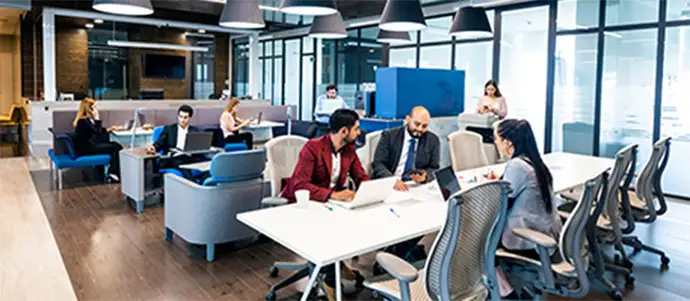As priorities and behaviours in the workplace continue to evolve, business leaders are working hard to steering their employees through the new world of hybrid working.
Best practice has not yet been fully established, and each organization is seeking its own way to succeed.
What’s driving hybrid working?
After months of remote working, workers are focused on their own needs; many want to retain some home working, and are threatening to leave if they cannot.
On the other hand, employers have learned to trust their workers to get on with the job, and have found valuable new KPIs based on activities and outcomes instead of location. Worker wellbeing is now a real driver.
Gartner ® states: “HR leaders must create a new, human-centric model that is fit for the hybrid environment by designing work around employee-driven flexibility, intentional collaboration and empathy-based management.”
And that means many organizations are rethinking the way they use their space, and drawing up hybrid working strategies to support an agile workforce.
Why do you need robust space data?
This situation has highlighted how individual the needs of every organization are – and workplace leaders are finding their way forward without a roadmap.
By capturing space data in real-time using leadership technology such as sensors, a genuine picture can be built up of how desks and meeting rooms are being used every day.
For the person designing the hybrid working strategy, it’s an invaluable aid to good decision-making.
How do you create a hybrid workplace plan?
These 5 practical technology-supported steps are crucial:

1. Tackle desking: Create a hot and fixed desk strategy that satisfies the needs of agile and office-based workers, but has flexibility built in.
2. Flex your meeting space: Design your space assignment flexibly so valuable space never stands empty. Create fit-for-purpose spaces for individual or group collaboration.
3. Go mobile: Give staff workspace scheduling via their mobile – remember to respond to developments in IoT and bring your own device (BYOD).
4. Deploy sensors: They identify booked but unused space as well as providing accurate utilization data.
5. Consider visitors: Give them touch-free check in and allow them to self-certify before arrival. Then deploy digital signage to help them find their way to the meeting.
How does the Rendezvous Workspace platform help?
Integrated workspace management technology includes several elements:
1. Desk and meeting space booking – agile workers locate and book workspace before coming into the office, using a mobile app. They check in and out using touch-free QR codes.
2. Conference scheduling – staff use the app to set up meetings or video conferences across multiple locations, booking space and equipment, inviting attendees and adding catering, parking and other services in one transaction. Changes are notified automatically.
3. Reverse hoteling – fixed desks are converted automatically into available hot desks when users are away.
4. Colleague location – workers can find out where and when their colleagues will be in the office to work on projects together.
5. Visitor management – provides enhanced entry into buildings and areas and reporting for health, safety and security.
6. Digital workplace technologies – as well as sensors, these include digital signage for wayfinding, and integrated in-room technologies, so meeting attendees can seamlessly start the meeting or place F&B orders without leaving the meeting.

Workplace leadership has a whole new feel
Gartner’s report: “Redesigning Work for the Hybrid World” says: “For decades, work design has been based on inherited assumptions that have damaging implications for equity, innovation and performance. The pandemic has revealed how outdated these assumptions are and given HR leaders an opportunity to make work design less office-centric and more human-centric.”
This requires a holistic approach from workplace leaders encompassing:
- Using good communications to build a new level of trust between employees and employers.
- Responding flexibly to changing requirements of the organization and each worker.
- Learning to lead with empathy in this worker-centric workplace for maximum productivity and wellbeing.
- Creating processes to drive innovation via collaborative practices.
- Putting technology is in place to support all of these areas.
Sharing experiences and best practice
Industry observer Luis De Souza, CEO of NFS Technology, says: “As a responsible technology company, our role has evolved from simply providing useful software tools for improving operational efficiency.
“By sharing our experiences of what’s working for our worldwide clients, and by offering practical advice, we aim to inform the hybrid working debate and help workplace leaders through the challenges.
“The holistic, worker-centric workplace is here to stay – and we know productivity, wellbeing and efficiency will thrive when technology is put at its heart.”
Gartner ®, Redesigning Work for the Hybrid World: Opportunities for Knowledge Workers, 2021. GARTNER is a registered trademark and service mark of Gartner, Inc. and/or its affiliates in the U.S. and internationally and is used herein with permission.


